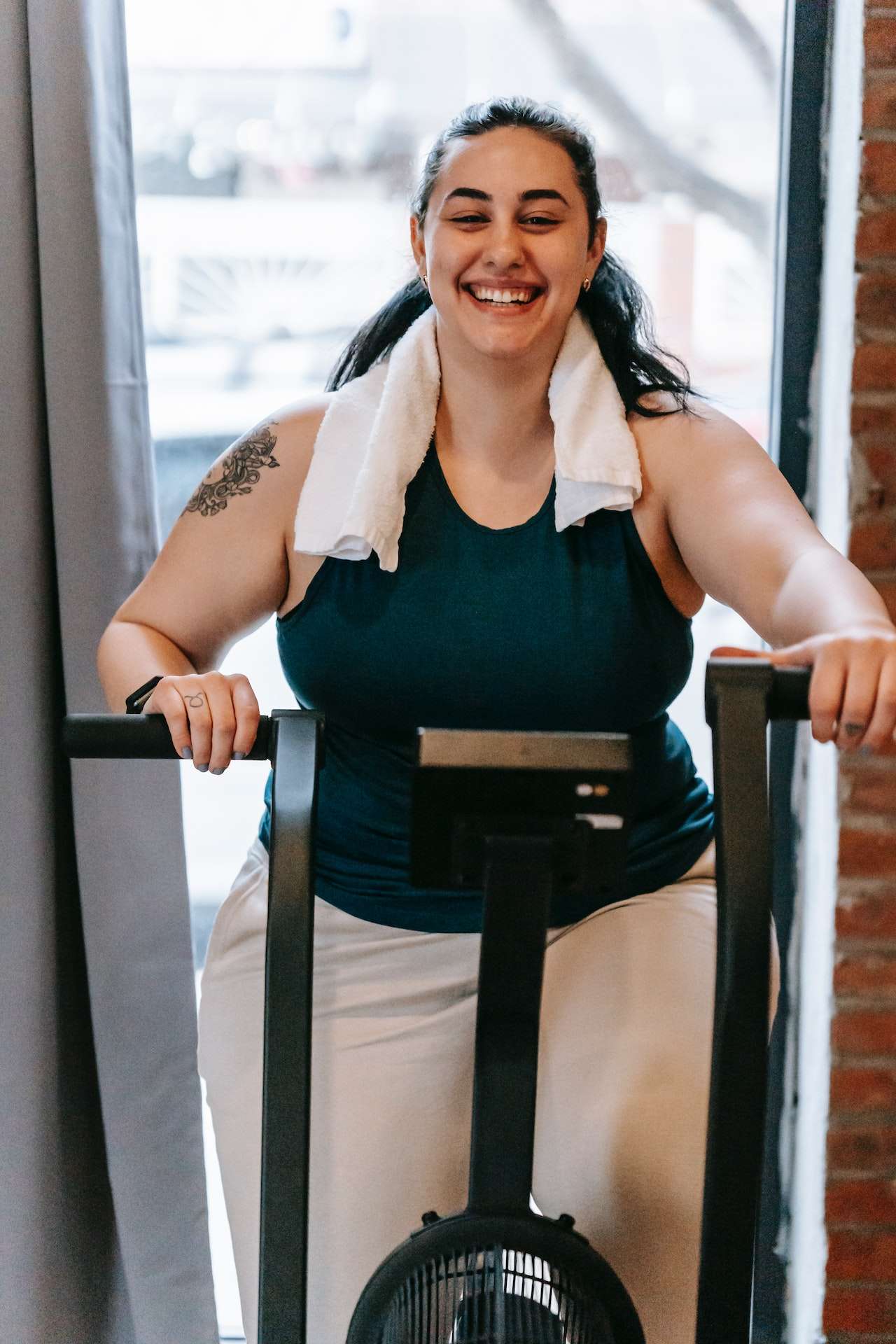|
Are you looking for a running routine that will help you lose weight? If so, you’ve come to the right place! Running is one of the most effective ways to burn calories and lose weight. In this article, I’ll explain the best way to start with a running routine to help you reach your weight loss goals. First, let’s examine why running is so effective regarding weight loss. When we run, our body burns calories to fuel our movements. If we run regularly, we can significantly increase the calories burned daily. In addition to burning calories, running helps build muscle and increases overall stamina, which can further aid in weight loss efforts. Finally, I’ll discuss creating an effective running routine for weight loss. We’ll examine how often to run, what pace to maintain during your runs, and how long each run should be. With this information, you’ll have everything you need to start your journey toward a healthier and lighter you!
Table of Contents
show
Weight Loss Through RunningThere is something incredibly freeing about the experience of starting a running routine for weight loss. The sound of your feet hitting the pavement, your muscles moving with each stride, and the feeling of accomplishment as you cross that finish line. As someone who has been running for weight loss for several years, there is no better way to achieve your fitness goals. Creating a running plan tailored to your needs and goals can be daunting initially, but it doesn’t have to be. To begin, it’s essential to set realistic goals that are achievable in the short and long term. For example, if you’re starting, aim for three weekly runs emphasizing distance rather than speed or intensity. You can gradually increase your mileage as you become more comfortable with running and your body strengthens.
Additionally, consider adding strength training exercises into your routine, such as squats or lunges, to help build muscle and maximize results from running for weight loss. Once you have a plan, it’s time to implement it! Start by tracking all aspects of your progress, including distance run, speed achieved during each interval, calories burned, and records of how you felt throughout each session. Keeping track of this information will help keep you motivated while giving you tangible evidence that you are progressing toward achieving your weight loss goals through running. It will also help identify areas for improvement and provide insight into how well different workouts work for you. With the right attitude and dedication to your running program, I’m sure that you’ll start seeing significant changes in no time! Importance Of Setting Realistic GoalsSetting realistic goals is essential when running for weight loss. We all have different starting points and fitness levels, so having an achievable goal is critical. This can help you stay motivated and prevent burnout. When creating a running routine for weight loss, it’s essential to consider factors like your current fitness level, schedule, and available time. Challenging yourself to see results is also necessary – it will take time! An excellent place to start is using a running-for-weight loss chart or guide that maps out a plan according to your needs. This way, you can tailor your running plan for intermediate or advanced weight loss, depending on where you are with your fitness journey. As you progress, consider incorporating other exercises, such as stretching or strength training. With consistency and dedication, you can create a successful running for weight loss routine to help you reach your goals safely and sustainably. By setting realistic goals at the beginning of your journey and building upon them over time, you’ll be well toward achieving the best possible running for weight loss results! Factors Affecting Running For Weight LossWhen it comes to running for weight loss, there are a few essential factors that need to be taken into consideration. While this type of exercise can be an effective way to shed pounds, it is necessary to understand the factors that will help you maximize your results and reach your goals. Rhetorically speaking, let’s dive in and explore what makes running for weight loss successful.
To get started, here are five key things you need to know:
By understanding these key elements preceding beginning any new fitness program, one can set themselves up for success when reaching their desired outcomes with running or any other form of exercise focused on weight loss goals. Now let’s move on and talk about how one might determine a starting point when embarking on their journey… How To Determine A Starting PointDetermining a starting point when running for weight loss can feel daunting. However, understanding the factors affecting running for weight loss is critical to finding the perfect routine. Whether it’s distance or speed, losing weight to help with running, a free plan, or an exercise plan that fits into your morning or evening schedule – these are all critical considerations. Just as important is ensuring your nutrition supports your goals so you can have a successful running weight loss transformation. It’s always best to start slow and small when beginning any new fitness activity. Taking the time to find out what works best for you will help ensure success in the long run. Assess your fitness level – do you need extra days off between runs? Do you need to ease into longer distances? Are there specific times of day that work better for you than others? Take the time to figure out what works best and stick with it! Once you’ve figured out your parameters and preferences, create a plan that meets your needs and gradually increases the difficulty as needed. Consistency is key – if something doesn’t work for you, try something else until it does! Being mindful of these factors will put you on course for a successful running journey toward reaching your weight loss goals. Tips For Starting A Running RoutineThe key is understanding your goals and finding an exercise plan to help you reach them. Starting a running routine for weight loss can seem daunting, especially if you’re new to running. But don’t worry- with the right approach and dedication, and you can create a plan that works for you! When creating your running routine, it’s essential to think about how long you want to spend on each run. This could be anything from 10 minutes to an hour- whatever works best for you! If you’re starting, shorter runs are great because they allow your body to get used to the activity without taxing it too much. Make sure you also incorporate rest days into your routine; this gives your body time to adapt and recover from the exercise.
Consider incorporating strength training into your running routine to help build muscle and burn fat faster. When doing resistance exercises, focus on movements that target your core muscles, like squats, lunges, crunches, and push-ups. This will ensure all of your body’s major muscle groups get the necessary workout. Additionally, include cardio exercises like cycling or swimming in between runs so that you can switch up your activities and keep things interesting. It’s important to remember that consistency is key to losing weight through running! Stick with your plan and stay motivated by tracking your progress and setting realistic goals; this way, you’ll see tangible results over time. With these tips, you’ll be ready to create a successful weight-loss running routine! Incorporating Strength TrainingIt’s undeniable that incorporating strength training into your running routine can be a powerful strategy for weight loss. The idea of working on both cardio and muscle-building exercises at the same time can be intimidating, even daunting, but it doesn’t have to be. With the right plan, running for weight loss with Beachbody and other programs can help you reach your goal faster and make it an enjoyable journey. Look at the running to lose weight chart and determine which exercise works best for your body type. From there, create a personalized running plan with the help of a reliable running weight loss coach. This will ensure you get the most out of each workout while keeping yourself safe from injuries. Mix some strength training exercises, too; think squats, lunges, and push-ups for maximum effect. Remember: if you can stick with this routine consistently over time, you’ll begin to see actual results very soon! Once your plan is in place, it’s time to implement it! You’ll want to focus on running weight loss exercises like sprints or hill climbs – anything that increases your heart rate without overexerting yourself. With any exercise plan comes the importance of proper nutrition; after all, what good is hard work if you don’t have the right fuel? Eating healthy meals and snacks throughout the day – such as fruits and vegetables – gives you an extra boost in burning fat and building muscle mass. So when combined with an effective running exercise for weight loss programs like Beachbody or marathon training, proper nutrition can be needed to hit your goals faster than ever! Importance Of Proper NutritionWhen running for weight loss, proper nutrition is as important as physical activity. Nutrition goes hand-in-hand with running; a good diet can make a noticeable difference in your performance, energy levels, and overall health. Eating the right foods can help you run better and also aid in losing weight faster. To ensure you’re eating correctly while running to lose weight, it’s important to have meals high in protein and complex carbohydrates. Protein helps build muscle and aids in recovery after a workout. Complex carbohydrates provide fuel and vitality during your runs to maximize the calories you burn.
Additionally, include lots of fruits and vegetables for vitamins, minerals, antioxidants, and fiber. Eating healthy fats like avocados, nuts, and seeds is also important since these are nutritious sources of energy that support your body’s natural processes. It’s also crucial to understand what foods won’t help you reach your goals when running for losing belly fat or any other type of weight loss goal. High-calorie snacks like candy or chips should be avoided because they don’t provide much nutrition or help with weight loss. Additionally, avoid sugary drinks such as soda or juice because they contain empty calories that will sabotage your efforts. To ensure success when trying to lose weight through running, it’s essential to maintain a balanced diet full of nutritious foods that will fuel your workouts and help you meet your goals faster. Avoiding Injury While RunningRunning is an excellent exercise for anyone who wants to lose weight and get fit. Research shows that running can burn up to 100 calories per mile! However, it’s essential to ensure you take the proper steps to avoid injury while running for weight loss plans. Resting your muscles and joints is the best way to prevent injury while running. Incorporate strength training into your routine at least twice weekly for maximal benefit. Make sure you’re stretching after each workout, too, as this will help with flexibility and reduce your chance of pain or soreness afterward. Additionally, try not to run on hard surfaces like pavement because this can cause muscle fatigue due to the lack of cushioning. Opt-in for a softer surface like grass instead for a more comfortable experience. Proper nutrition is also crucial when running for fat loss plans; you must fuel your body correctly to get the most out of each workout. Choose foods packed with nutrients that will give you energy and support your goals, such as lean proteins, complex carbohydrates, healthy fats, fruits, and vegetables. Also, ensure you drink plenty of water throughout the day, which will help keep you hydrated during your runs. With a balanced diet and proper exercise plan, you’ll be well on your way to achieving your running and weight loss goals! Incorporating Interval TrainingInterval Training is a great way to get into running for those looking to lose weight fast. It’s the perfect balance of pushing yourself but not too much that you risk injury – like the idiom ‘everything in moderation.’ Many people are split between going for distance or speed when running for weight loss. Interval training is an excellent way to bridge this divide. You can alternate sprints with longer runs or do shorter bursts at different speeds. This allows you to switch up your running workout and keeps it interesting so you don’t become bored.
If you’re following a keto diet while running for weight loss, interval training can help you reach your goals faster than just long-distance jogs alone. Short bursts of increased effort help increase your heart rate and burn more calories simultaneously as a standard run. If you can access a treadmill, various interval programs pre-set on most models can guide your workouts. While some people have amazing stories about how they managed to lose weight just by running every day without fail, most people need variety in their workouts to stay motivated and prevent boredom from setting in – which is why cross-training is essential… Cross-Training To Prevent BoredomLosing weight is a journey that requires a lot of motivation and dedication. But you know what’s even more challenging? Staying motivated! Running for weight loss is one of the most popular ways to shed those extra pounds, but it can get boring quickly if you don’t mix up your routine. That’s why cross-training is critical to creating a successful running for weight loss transformation. For example, if you’re looking for a running weight loss workout plan emphasizing toning your lower body, adding some HIIT can be a great way to mix things up and challenge yourself further. Cross-training can add variety to your running plan for weight loss beginners’ regime, keeping you motivated and engaged when running for weight loss or other conditions. And how many miles of running will help you lose weight? There are no hard and fast rules here – make sure that whatever type of exercise you choose fits into your lifestyle and schedule so it doesn’t become another burden on top of everything else in life! Staying MotivatedStaying motivated while running for weight loss can be difficult, especially when the scale isn’t budging. But with a few simple steps, you can see results and stay motivated to continue running towards your weight loss goals. First, you must understand that you will only lose weight in your legs, as running is a full-body exercise. However, running is an incredibly effective cardio for burning calories and losing weight overall.
It doesn’t have to be all-out sprints; even walking or jogging steadily can help you burn calories and lose weight. Stories from other runners who hit their goals help motivate you to keep going. Alternatively, try speed intervals or running hills instead if the number on the scale isn’t moving quickly enough. Also, consider adding supplements to your diet if you need help with your progress. Protein powders can help keep muscle mass intact as you reduce calorie intake and will also help with hunger control and cravings. If all else fails, slow down! Sometimes consolidating the intensity of a workout allows us to stay consistent and reap more benefits over time than going hard too often and then having to take breaks due to injury or exhaustion. So remember – consistency is key! Frequently Asked QuestionsIs Running The Best Way To Lose Weight?When it comes to weight loss, running can be a great equalizer. It is a simple and effective way to get in shape without investing in expensive gym equipment or hiring a personal trainer. It can also be done virtually anywhere, allowing people to get outside for fresh air and sunshine while working out. Getting started is the only real obstacle – it takes motivation, dedication, and consistency. But running is more than just a physical activity: it is symbolic of taking charge of your life and making positive changes. When you lace up those shoes and hit the pavement, you are setting off on a journey that may seem daunting initially but will pay dividends in the long run. You are proving to yourself that you have the power to make your dreams become a reality – no matter how far away they may seem right now. Starting this journey isn’t easy, but it’s worth every step. Begin by finding an enjoyable route that allows you to explore new scenery and surroundings; this will keep your motivation high as you progress into your running routine. Make sure to warm up with dynamic stretching exercises before each session, then start slowly and gradually increase your pace over time as your body gets used to the movement and exertion. Listen to your body’s signals – if anything doesn’t feel right, take a break or reduce intensity until you feel better again. With focus and determination, you’ll soon be reaching those weight-loss goals! What Type Of Shoes Should I Wear When Running?When running for weight loss, your shoes can significantly impact you. Wearing the wrong type of shoe can lead to injuries and pain that may derail your progress. On the other hand, choosing the right pair of running shoes can make all the difference in your running experience. Finding the right pair of shoes is like finding a key to unlock success. The symbolism of opening something previously inaccessible or out of reach helps to create the feeling of mastery. This is why it’s so important to find a good pair of running shoes – they are essential for achieving your goals and helping you stick with your routine. The most important thing is comfort and support. When shopping for running shoes, it’s best to try on a few different pairs before purchasing. Look for cushioning on the sole, arch support, and breathable material that keeps your feet cool during runs. It’s also essential to choose shoes that fit correctly; be sure they’re snug but not too tight, as this could cause blisters or other foot issues down the line. You should also get fitted at a specialty store or use an online sizing guide if you’re shopping online. Once you have found your perfect pair of running shoes, you can confidently hit the ground running! With comfortable footwear, you can focus on what matters most: reaching your weight loss goals and sticking with your routine without worrying about discomfort or injury holding you back. How Often Should I Take Rest Days?Rest days: the magical elixir for any running routine. They are like a tall glass of cool water on a hot summer day – refreshing and necessary. Rest days are essential for running for weight loss if you want to make progress and avoid burnout. So, how often should you take them? It all depends on your individual goals and preferences. To help you decide what’s best for you, let’s look at the three main ways to structure your rest days:
No matter which approach you choose, always listen to your body! If you’re tired or sore from a previous run, take an extra day off and let yourself recover fully – this is especially important if it’s been less than 48 hours since your last run. Sleep well and eat healthy foods while resting; these will help boost performance during future runs! Your running routine should be tailored specifically to meet your needs, so experiment with different approaches until you find something that works well for you. Remember that taking regular breaks is vital to continue progressing toward reaching your weight loss goals! How Quickly Can I Expect To See Results?When running for weight loss, the question of how quickly you can expect to see results is essential. Like many fitness journeys, most people want quick results – but this is only sometimes realistic. The truth is, seeing results from running takes time and dedication. It’s important to remember that everyone’s bodies react differently when they start a new exercise routine. Some people may see faster results than others, while others might only see gradual progress over a long period. That being said, if you stick with your running routine and take care of your nutrition, you should begin to notice changes in your body and overall health within a few weeks of starting. The key here is consistency: sticking with your routine over the long term and keeping going even if the initial results are slow-coming or not as dramatic as you’d hoped. It may be frustrating sometimes, but if you stay dedicated and focused on reaching your goals, those minor improvements will add up over time and eventually make all the hard work worth it! Should I Start Running Indoors Or Outdoors?When starting a running routine for weight loss, one of the significant decisions you must make is whether to run indoors or outdoors. It’s essential to consider your preferences and lifestyle to choose the best option. Running indoors may be the way to go if you’re seeking convenience. With access to a treadmill, you can get started immediately without worrying about the weather or finding a safe route if you’re running at night. You can also use various apps and technologies like fitness trackers and streaming classes that will help motivate and encourage you throughout your runs. On the other hand, running outside might be more up your alley if you thrive on being outdoors. Getting out in nature can relieve much-needed stress while providing physical benefits like improved peripheral vision and balance. Taking in different scenery while running can also make it more enjoyable than running on a treadmill day after day. At the same time, there are potential risks that come with outdoor running, so it’s essential to take safety precautions such as wearing reflective clothing and staying alert when exploring unfamiliar areas. Ultimately, indoor and outdoor running has advantages and disadvantages depending on your needs and goals. Think carefully about what works best for you before diving into a new routine so that you can get the most out of your workout experience! Conclusion:Yes, running is one of the best ways to lose weight. It’s a great way to get your heart rate up and burn calories, making it perfect for those looking to shed unwanted pounds. You’ll be off to a fantastic start with the right shoes and a good starting routine. When it comes to running for weight loss, consistency is critical. Make sure you give yourself rest days to refuel and recharge to go full force when you hit the pavement or treadmill again. By sticking with your routine, you’ll be able to reach your goals in no time—it’s like magic! Overall, running is an effective way of losing weight if done correctly. With the right gear, plenty of rest days, and dedication to your routine, you’ll reach your goals quicker than you ever thought possible! So lace up those shoes and get going—you won’t regret it. |






